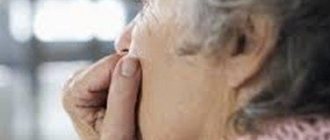Medical information is reliable Checked by Shaidullin Renat Flyurovich
Dementia is a common companion for older people. This is a severe progressive disease that brings significant discomfort to everyday life. The patient almost always does not realize what is happening to him. All concerns related to everyday life and other areas of the patient’s life fall on his loved ones. An unhealthy person needs round-the-clock care; he cannot care for himself. This is a disease whose development can be slowed down by undergoing regular treatment at Dr. Isaev’s Clinic. We use modern recovery methods, bringing back to life even seriously ill patients who were considered hopeless in other medical institutions.
Dementia in older people
Translated from Latin, the word means “dementia.” The main reason is organic damage to the brain, leading to dysfunction of higher nervous activity. The patient's mental abilities decrease, he cannot perform basic calculations, practical skills and knowledge are lost, and it becomes impossible to acquire new ones.
Our clinic specialists are guided by a complete medical history in the treatment of dementia. The clinical picture depends on the location of the brain lesion, its extent, the prerequisites for the development of the disease, age and general health.
The danger lies in the persistence of the disorder; it only progresses over time. Initially, the defeat affects intellectual activity, then disturbances in the emotional-volitional sphere become noticeable. The final stage is the complete and irreversible disintegration of personality.
Types of dementia
Experts classify the disease into three areas. They are distinguished by the extent and selectivity of damage to the body:
- Atrophic (Alzheimer's) - occur due to malfunctions of the nervous system.
- Vascular – acts as a concomitant disease, the primary source of which is impaired blood circulation in the brain.
- Mixed - combines the features of the vascular and atrophic types.
According to statistics, atrophic type dementia is more common in older women than in men.
The classification of dementia depending on the location of the brain lesion is as follows:
- cortical - the cerebral cortex is primarily affected (Pick's disease or Alzheimer's disease);
- subcortical – pathology affects subcortical structures (Parkinson’s disease with neurological symptoms);
- cortical-subcortical – there are disturbances in both the cortex and subcortex;
- multifocal – damage to the nervous system in all parts.
There are lacunar and total dementia. In the first case, there is damage to the structures responsible for intellectual activity. A person cannot remember what happened to him 5 minutes ago, but at the same time he calmly reproduces in his memory the events of twenty years ago. His short-term memory suffers, and a number of associations are significantly impoverished. His intelligence fails, sometimes even simple things become inaccessible to understanding. The patient is critical of his condition and is aware of the problem. The emotional-volitional sphere is practically not affected; symptoms include increased sensitivity and tearfulness.
In the case of total dementia, the situation looks much more serious. This type of disease is accompanied by gross changes in the intellectual and emotional-volitional spheres. Life interests are lost irrevocably, moral values fade into the background, and there is no sense of shame for unseemly actions. Such patients cannot remain full-fledged members of society, as they are completely maladapted. Our clinic treats suicidal behavior and senile dementia using new, safe methods.
Types of pathology
There are several types of classification of senile dementia. The most common is based on the mechanism of development of the disease. The following types of pathology are distinguished:
- Alzheimer's (atrophic): based on a degenerative process in the cerebral cortex, most often found in Alzheimer's disease;
- cerebrovascular: occurs against the background of chronic insufficiency of blood supply;
- mixed.
The location of pathological foci is the basis of the second classification: cortical, subcortical, mixed and multifocal forms of dementia are distinguished.
Clinical manifestations allow us to distinguish two variants of the disease:
- lacunar dementia: mainly the intellectual sphere suffers, memory suffers, but the person is aware of himself and can assess his condition;
- total: loss of self-service skills and inadequate perception of reality.
Signs of dementia
Regardless of what type of disease the patient has, the complex of clinical manifestations of the disease is almost the same. When you first notice signs of dementia, you must urgently consult a doctor in order to make an accurate diagnosis and draw up a treatment algorithm.
Alarm bells that the patient’s relatives should pay attention to are the following factors:
- Impairment of short-term and long-term memory. It manifests itself in the form of an inability to remember new information or reproduce the events of the past day or past years. Patients make every effort to activate their memory, but they fail.
- The patient cannot fully assimilate new information or acquire skills that he did not have before. These people lose the ability to learn, cannot remember the sequence of actions and lose touch with reality.
- Disorientation in space. A person easily gets lost in open areas; he does not remember his residential address and telephone number. Sometimes he cannot clearly answer the question what day and year it is. Such elderly people are often brought to the police by vigilant citizens. Only law enforcement agencies can figure out where an elderly person comes from and where to look for his relatives.
- There is no desire to learn something new, since this information cannot be processed by the brain at the same level.
- The critical attitude towards oneself and one’s actions is lost, the patient ceases to distinguish between what is bad and what is good. He falls into childhood, losing all the signs of an adult.
- There is no planning for the next days and months of your life. Patients with dementia live one day at a time.
The disease is getting worse every day, these manifestations are intensifying. New signs of dementia appear, even more destructive and dangerous.
Diagnosis of dementia
Diagnosing dementia can be difficult due to the fact that the range of symptoms and causes that led to cognitive impairment can vary significantly between patients. As a rule, the diagnosis of dementia takes place in several stages and begins with an initial consultation.
To clarify the clinical picture, it is important for the doctor to:
- talk with the patient or person caring for him, collect anamnesis. The doctor uses a questionnaire specially developed for this purpose and finds out when the first signs of dementia appeared and what exactly the cognitive difficulties are. Next, the specialist asks questions about the patient’s lifestyle and health and finds out which risk factors are present;
- assess physical condition - gait, coordination of movements, fluency of speech;
- conduct a short cognitive test using one of the methods accepted in the medical community;
- determine whether dementia is caused by reversible or irreversible causes. This may require laboratory tests.
If the initial conversation and examination is conducted by a therapist, he has reason to suspect the development of dementia, the doctor will refer the patient to a specialized specialist for detailed diagnosis and further treatment.
People often hesitate to see a doctor because they are afraid to hear the diagnosis of dementia and attribute the first signs of the disease to normal age-related changes. But this is a fundamentally wrong tactic, because the earlier the syndrome is identified, the greater the chances of prolonging the usual full life and delaying severe manifestations of the disease.
Diagnosis of the disease
Suspicion of dementia is a good reason to see a doctor. This pathology is dealt with by a therapist, a neuropsychologist, a neuropathologist, a psychiatrist and a specialist who deals with diseases of the elderly. The diagnosis is made after interviewing the patient’s relatives and the patient himself. Important information is:
- age;
- characteristic signs;
- frequency of symptoms;
- time of onset of pathology.
A comprehensive neurological examination using modern equipment allows us to determine where the foci of pathology are located. The diagnosis is finally made only when symptoms are observed for six months and intensify over time.
A number of psychological tests are carried out to assess cognitive function. They make it clear at what level of consciousness the patient is. During testing the following is established:
- degree of orientation in space;
- features of attention;
- volume of short-term and long-term memory;
- thought processes (abstract, logical);
- the presence or absence of hallucinations, illusions;
- ability to think critically and plan.
Lifespan
Dementia leads to the breakdown of a person's psyche. In most cases, the average life expectancy of such patients is 5-10 years. However, much depends on the cause of dementia and the age when the syndrome was identified. For example, young people can live with dementia for up to 25 years after diagnosis.
In rare cases, dementia is caused by malignant tumors and infections. Such types of dementia can be reversible if the underlying disease is treated in time. Therefore, for such patients, life expectancy may differ significantly from the indicated 5-10 years.
What should relatives do?
A person with dementia in the family brings a lot of inconvenience.
In severe cases, the patient can pose a danger to others. For example, turn on the gas, open the tap and flood the neighbors, or leave the house. In such cases, the patient will have to be admitted to a hospital. If you notice signs of dementia in your loved one, contact your doctor immediately. These are geriatric neurologists and psychiatrists. You should not take independent actions. Often, wanting to help, relatives force the patient to learn poetry or solve crossword puzzles. This is not only useless, but also harmful practice that will only give rise to conflicts.
Cognitive training for people with dementia will indeed be useful, but it is selected by a specialist. It is important that a person engages in activities that bring pleasure. For example, if your mother or grandmother loves to embroider, then don’t deprive her of this pleasure now. The only thing is to choose simpler embroidery options for it.
To slow the progression of dementia, it is useful to play games such as chess, checkers, dominoes and others. However, if the patient does not want to play, then under no circumstances should he be forced to play. If physical activity allows, then you need to walk in the fresh air every day.
The patient's relatives also need to read about dementia - find out what kind of disease it is, how it manifests itself, what difficulties may arise in the future, and so on. Understanding these things will help you avoid conflict situations.
Dementia causes
The main prerequisite for the occurrence of dementia is damage to the central nervous system. The degeneration of brain cells leads to the fact that the personality is gradually destroyed. With such lesions, the disease develops independently. There are a number of diseases in which senile dementia is one of the associated complications. Among them:
- alcohol abuse in the final stages;
- cerebral atherosclerosis;
- high blood pressure;
- malignant or benign formations of the central nervous system;
- strokes;
- trauma and mechanical damage to the brain;
- infectious, viral diseases (meningitis, encephalitis, HIV);
- renal and liver failure;
- dysfunction of the endocrine system;
- lupus erythematosus;
- complications due to hemodialysis;
- multiple sclerosis.
If the patient has immediate family members who have been diagnosed with dementia, this is an additional risk factor. Diabetes mellitus and obesity can also trigger the development of this disease.
Is dementia incurable?
Indeed, modern medicine is not yet able to completely reverse the process and cure the onset of dementia. But it is wrong to treat dementia as an irreparable condition in which any treatment is pointless.
It is impossible to do without maintenance therapy, because it can greatly alleviate symptoms, slow down the progression of the disease and improve the quality of life of patients with dementia. In addition, dementia can have a different nature; it is not always caused by incurable neurodegenerative diseases. In some cases, the syndrome is caused by metabolic disorders or infections that can be treated.
Dementia symptoms
Dementia belongs to the category of diseases that do not simply go away and progress. Depending on the patient’s current socialization capabilities, three stages of pathology are distinguished. Each of them has its own specific set of symptoms.
- First stage. The patient already has noticeable intellectual impairments. There are complaints that he cannot remember events in his life and forgets his address. A critical attitude towards his condition remains, the person understands that he needs to see a doctor for professional help. Any household activity is carried out in full, self-service remains at a high level. Such patients follow the rules of hygiene, can cook their own food, and clean the house. At this stage, round-the-clock care is not yet required.
- Second stage. The development of the disease is accompanied by severe intellectual impairment. The person does not remember whether he turned off the gas or the iron, closed the doors and other things important in terms of safety. The patient does not realize the criticality of his situation; he does not believe that he is sick. There is a risk that older people with dementia may cause harm to themselves or others through carelessness, without malicious intent. They require regular care; leaving such a person alone is unsafe.
- Third stage. It is the most severe, characterized by complete collapse of personality. The symptoms of dementia are especially pronounced here. Usually such changes in the brain are irreversible. At this stage it is very difficult to stop the further development of dementia. Patients do not recognize their friends, family and loved ones. They cannot feed themselves and must be spoon-fed. Even if in rare cases hunger prompts them to search for food, older people cannot distinguish good foods from bad ones. They cannot maintain good hygiene, so they need constant care around the clock. The ability for logical thinking gradually fades away, they cannot connect two facts together. Verbal communication with others is reduced to zero; they are constantly in silence. The third stage is characterized by apathy and a depressed mood. There is no feeling of thirst or hunger; if the patient is not fed for a long time, he will not ask. Movement disorders lead to the fact that a person cannot perform the simplest movements - chew, swallow, walk. Unfortunately, this stage sooner or later leads to the death of the patient.
It might be possible to limit this work to the clinical report we have just made. That would be the easiest thing. Without hoping to give correct answers, even if incomplete, to such complex questions that Kraepelin's concept raises, we think that we should now analyze which direction of clinical research in our observations can determine them.
I. Historical review of the problems of early dementia and schizophrenic conditions as clinical cases
When you consider the mass of clinical facts that we have just cited and testify to various cases in which, as a rule, a diagnosis of “early dementia”, “hebephrenia”, “catatonia”, “paranoid dementia”, “schizophrenia”, etc. is made, then absolutely clearly understand the order and nature of the questions posed [1].
The first facts that struck the medical profession were those of the first three groups, characterized by a state of rapid dementia affecting young people, especially “young adults.” Just as in our country Morel “feels” this group of cases, so Kahlbaum (in 1863) speaks of “paraphrenia hebetica”. Naturally, Kahlbaumy should have immediately become interested in a group of especially pure cases - cases of group 2, where motor disorders predominate. Thus, he united a certain number of cases, in the old way called “melancolia attonita” (Bellini), “catalepsy” (Bourdain, 1841; Puel, 1858; J. Falret, 1857), into the painful unity “Spannungsirresein” (madness of muscle tone) , which he described as a cyclical affect, that is, evolving in four phases: melancholia, mania, melancolia attonita and dementia. He described many of its forms: Katatonia mitis, Katatonia gravis, Katatonia protacta in remitting and intermittent form, examples of which we will find in our 2nd group.
Kraepelin, the true creator of "dementia praecox", struck by the analogy of the cases that we grouped into the first three categories, included (in the 1899 edition) Kahlbauma's catatonia in his first concept of dementia praecox, which corresponded only to cases of the 1st group, that is, hebephrenia, studied first by Kahlbaum, then by Heckerom, and to it was added delusional forms with rapid dementia (our 3rd group). The thought that guided him was the thought of Kahlbaum and all psychiatrists of the late 19th century: it was about reproducing the disease according to the model of general paralysis. By the way, this is exactly how early dementia was perceived in France by the most famous psychiatrists of that time: Christian in 1899, Seglas in 1900, Serie in 1902. Thus, this nosographic group was formed on the basis of facts similar to those we cited in our first three groups, especially as regards “young” (the concept is not entirely accurate) objects. The main clinical criteria for this unity were: the evolution of dementia and fundamental affective disorders.
This unity carried significant potential for dissemination, which will become quite clear if we consider that many forms (11 out of 48 in our clinical material) represented and represent the evolution of delirium to dementia. In this case, a problem must necessarily arise, which was the subject of Kraepelin’s study in various editions of his “Manual”. Let us formulate this problem in relation to the above facts: on what basis can we attribute groups 4, 5 and 6 to a unity that includes the first three groups?
For a long time, at least since the studies of J. - P. Falret on the evolution of delirium of persecution and Magnan on the evolution of the famous chronic delirium, it was known that many deliriums evolve to a more or less demented form of incoherence. Should they be brought into the early dementia group or taken out? Kraepelin's hesitations on this matter are known and the fact that by his group of paranoid dementia he meant the entire sector of delirium, covering the 4th and 5th groups. As for the 6th group, it was he who created it, and from the very moment of its creation he asked himself a question that would not leave him until the end of his life: does it really constitute an autonomous clinical type in relation to early dementia?
In France, this widespread use of the concept of early dementia frightened many psychiatrists, for whom it contradicted the perception of the concept of primary dementia, which included, or tended to include, all cases considered to be secondary or vesantine dementias. Such resistance was finally broken at the Congress of Pau in 1904, when Denis, who gave a report on vesanic dementias, presented them as a form of Kraepelinian dementia. Thus, the path to expanding the concept of early dementia turned out to be open towards more and more numerous delusional forms corresponding to our 4th and 5th groups. The French resistance to the Kraepelinian invasion, if we can express it this way, at the same time manifested itself in the creation of three unities designed to limit the spread of “early dementia” towards chronic delirium:
- groups of chronic hallucinatory psychosis,
the purpose of which was to preserve the 4th and 5th groups;
- groups of “delusions of the imagination”,
the purpose of which was to preserve the 6th group, and ultimately create a kind of even stronger position of withdrawal into oneself;
- nonsense interpretation of Ser¨ and Capgras. This type of delirium was, as it were, protected by the expansion of the concept of early dementia, because it represented a delirious structure, completely different from many deliriums grouped under the name of chronic hallucinatory psychosis (groups 4 and 5), in which, on the contrary, it was difficult to maintain concepts from destruction or inconsistency, those concepts that (as the early dementia group spread) sought to replace the concept of primary initial dementia. Analyzing the clinical facts relating to various groups, let’s not hesitate and ask ourselves: is it true that all these patients with profoundly changing personality are really demented? It was to the study of this question, which is posed, in particular, by diseases of the 2nd group, that Bleuler devoted long-term research, culminating in his unforgettable work on “Dementia praecox or the group of schizophrenia”
(1911).
In it, he argues that the fundamental disturbances of these various conditions are not dementia and affective disorders, but a disorder of mental activity that renders the sufferer unable to perceive reality normally and plunges him into a psychological vacuum or maintains him in a form of incoherent, affective thought, which he calls autism.
Naturally, with the introduction of this concept, the Kraepelin group expanded significantly, which led to the identification in Germany, Switzerland and little by little in other countries of a certain form of disorder, covering almost all deliriums and a large number of other psychopathic conditions:
“schizophrenia.”
It has expanded so much that these two psychoses, which arose along with
“manic-depressive illness,”
together account for 4/5 of mental illnesses! This is how the seven groups of facts that we studied are united by the concept of schizophrenia, whereas the original group of “early dementia” included only the first three.
It was precisely this expansion of the concept of “schizophrenia” that Claude protested, proposing to consider, on the one hand, the facts of the original group (approximately the first three groups), and on the other, conditions inevitably characterized by implied autistic activity and disturbances of instinctive-affective activity. In the understanding of Minkowski, who somewhat “freely” interprets Bleuler’s concepts, this is an activity typical of schizophrenia. The work of Claude and his students took into account facts similar to those of our 7th group, a number of initial forms of catatonic evolution (2nd group) and delinquent schizophrenic disintegration (5th group).
This, in general terms, is the historical development of the concepts of early dementia and schizophrenia, clearly understood provided they are related to various groups of facts, which we have done.
II. Does the set of conditions grouped under the name “early-onset dementia” or “schizophrenia” constitute some kind of unity?
To establish clinical unity, it is necessary to clearly indicate what is identical within a group (concept understanding) and what distinguishes this group of facts from other facts (concept expansion). Of course, it is quite difficult to apply such a precise method, imbued with too strong a geometric spirit, in the biological and psychological sciences. Without becoming slaves to precision, one can at the same time demand from both the clinical group and everyone representing the “disease” that this group be clearly defined by practical, obvious criteria. Are we really dealing with “early onset dementia” or “schizophrenia”?
The criteria that were available at the initial stage of history and, so to speak, from the birth of early dementia, were: fundamental dementia evolution, affective indifference, onset in adolescence and catatonia.
The fact that in many cases the evolution of dementia was manifested,
seems obvious.
However, this dementia is often less profound and more advanced
than Kraepelin could have imagined, and it is this difficulty in determining the depth of actual negative impairment that is the practical obstacle to any precise limitation. We know something because in many cases we hesitated for a long time and were able to group our patients with great uncertainty. In particular, many of them experience a sudden cessation of volitional action and blocking of mental activity, especially in patients suffering from catatonia, who may be more prone to dementia. Therefore, Bleuler, who enjoyed well-deserved authority, protested against the idea that these patients were demented. However, it seems that the criteria for dementia tend to narrow the boundaries of the group too much and not allow it to be sufficiently defined. In fact, a little more - and we will reach such a paradox that we will say about two similar patients suffering from catatonia, that one of them is a patient with early dementia, and the other is stricken with another disease, only because the first would have lived a vegetative life for only a few months, and the second would have remissions, he could still (which is remarkable) read and work after twenty years of evolution.
poses much the same problem .
If we consider a patient who has been evolving for many years to be weak-minded and unconscious, then he will seem completely indifferent, but what do we say about other dementia patients: paralytics and old people, bedridden and inert? If we want to indicate by this that affective indifference is, in early dementia, an initial sign, then we also doom ourselves to insurmountable difficulties. How many such patients have been seen suffering from attacks of tragic anxiety and - often and for a long time - showing very vivid feelings! Even if we see how these patients cannot get out of their incoherent and stereotypical delirium, then in this case we cannot call them patients with early dementia? Finally, if, as proposed by Deed and Giro or Bertse, we consider the decline in vital impulse (atimormia) to be the fundamental disorder, then we agree that the plane of bifurcation determined by this criterion reaches quite delicate clinical discriminations. How do we diagnose an impulsive, catatonic, rebellious, stubborn, negativist who gets angry and goes into a rage? We noted in our patients how often deformation rather than cessation of their sensory life manifested itself, how often their affective disturbances were paradoxical fixations or impulses. So, if affective disturbances are frequent and sometimes typical, then it is quite difficult to narrow down without loss the group of patients with early dementia to patients demonstrating zero affectivity or even deep indifference.
As for the appearance in adolescence,
then this, naturally, can be turned into an easy criterion if it is attributed not only to early dementia, but to any condition that evolves to dementia and began before 18 or 20 years of age; but how can one fail to understand that typical evolutions can be observed at an exceptionally advanced age? Without getting to the question (and perhaps this is not at all absurd) about whether dementia or schizophrenic evolutions sometimes appear in old people, contrasted with the forms of adolescence, we can stay within more acceptable boundaries, asserting that such evolutions as the evolutions of our patients G... (3), L... (31), B. B... (45), indicate, for example, that the age of onset can be quite advanced (from 35 to 40 years), even with rapidly occurring forms of dementia.
Catatonia -
The syndrome is also difficult to define. Either it is given too narrow definitions, reducing it to fixation of segmental postures, i.e. catalepsy (which is an absolutely exceptional phenomenon), or it is stretched to individual signs, such as unmotivated rituals or stereotypical or mannered behavior. We strive to distinguish in each of our patients his “degree” of catatonia, noting whether we are talking about typical and complete catatonia with catalepsy, typical catatonia with stupor and negativism, a set of fairly clear signs (for example, grimaces, stereotypes, impulsivity), some individual characteristic or, finally, about a certain stereotypical behavior. From observations, we conclude that these disorders, with varying frequencies, are extremely common among our patients, including groups 5 and 7 (but not 6). We believe this is another of the most consistent criteria. By the way, it is to violations of this kind that most often in the clinic they refer to the meaning of “discord”. Based on this, all that remains is for the most elementary clinical analysis to show that these signs of catatonia are just an expression, a reflection of deeper disturbances in mental activity. If - in order to defend some theories - clinicians forget about this, then from practice they should know perfectly well that these disorders are an expression of a deep-seated mental disorder, an expression very frequent, but unstable, and, according to Bleuler's terminology, secondary.
This brings us to consider the Bleuler criterion for this group of schizophrenia;
in his opinion, this is a special state of mental personality disorder that he calls
autism,
that is, thinking without logical connections, crystallized around unconscious affective complexes.
The totality of clinical signs of the disease borrowed its character of disorder from certain incoherent dreams. In particular, it is enough to carefully read those sections of Bleuler’s work that talk about catatonia, delusions and hallucinations in order to understand that together with him we touched on something new in this area of psychopathology, a kind of key to many states of disorder, decay, catatonia. But it seems that in all these cases, and especially in the course of the evolution of each case, something more decisive intervenes [2]: a series of negative disorders
from a simple weakening of thinking to deep-seated dementia. It seems to us, without any doubt, that many of our cases, in particular the cases of the first three groups, may have passed through a phase of autistic activity, perhaps a rapid one, but that nothing significant would remain from it, thus indicating that negative disturbances are decisive and essential.
So, let us take into account the various features that are offered to us by eminent clinicians and have been tested by the traditional, patient, careful semiological clinic. They all have some, but not complete, value. What can we say if it is not (which we all perhaps understand by the declaration “this is from early dementia”, “this does not apply to her”) that it is not reducible to one criterion or another? Maybe this happens because we are actually less victims of the doctrinal dogmatism of unities than we say about it, maybe this happens because for ourselves we do not quite formulate the question in the same way as we announce it (“this disease is early dementia?”), but also how we conceptualize it (“is it about the destruction of mental life?”).
Let us return to the brief historical overview outlined above. Initially, there was hope that a syndrome had been discovered that was pure enough to be linked to etiology, as happened in the case of paralytic psychosis. Many of us retain hope that “early onset dementia” is a disease. It is this hope that inspires research into specific etiologies, and more recently into tuberculosis. This is what encourages us to see in some therapeutic agents a special treatment. In this sense, the hypothesis is fruitful; let’s keep it, but only until the moment when it becomes sterile. After all, the expansion of the concept of early dementia was not only subject to a peculiar whim, fad, or, if you like, contagiousness, it reflected the indisputable fact: there is a whole gamut, a whole chain of very similar conditions, starting with our first groups and right up to the last; it is impossible to isolate from this sequence anything other than various evolutionary aspects; It is impossible to identify a clinical picture that is typical enough so that, without comparing other somatic signs or a specific etiology, it would be possible to define it as a disease.
This allows us to say (or, rather, to state, because so much has been said and written about early dementia) that the totality of disorders caused by early dementia, catatonia, schizophrenia, has only the meaning of a syndrome and that it is futile to conduct research in the direction of etiology alone. Indeed, the few information we have collected about the actual pathology of these conditions and which reliably corresponds to the experience of each of us indicates how many different - hereditary or acquired - processes can be the subject of discussion. Who can believe, given several serious arguments, that the day will come when a single etiology will “account” for these ways of special division of mental activity, which we call “early dementia” or “schizophrenia”?
Thus, what is called early dementia, what others call schizophrenia, referring to different criteria, we consider to be a multiplicity of conditions caused by a multiplicity of etiologies, or rather a series of different levels of breakdown of mental activity, the common features of which seem to be however, they depend on the process itself (negative disturbances), just as mental reactions depend on this process (positive disturbances).
III. Pathology and nosographic significance of various disorders united by the concept of “early dementia”
Let us return to the facts we have presented, which were considered from an evolutionary point of view. We noted four main evolutions - hebephrenic, schizophrenic, schizopraxic and paraphrenic forms.
The hebephrenic structure (the first three groups) is characterized by the importance and speed of evolution of negative signs, that is, a deficit in the ability of mental activity. Without indicating the true state of demented destruction, which is much less common than is usually believed, these cases evolve towards a global decrease in activity, the extinction of affective sources adapted to life in relationships. It is accompanied by a way of organizing mental life that Bleuler called autism. But we are talking about a very degraded autism, often residual and always transitional. With it, catatonic disorders are very common.
The schizophrenic structure (groups 4 and 5) is characterized by negative dissociation disorders, the most notable feature of which is the destruction of the functions of verbal expression (ideo-verbal incoherence) and personality cohesion. In such cases, autistic activity is high. We are talking about a delinquent organization of an essentially hallucinatory structure, in which a patient suffering from schizophrenia constantly experiences a “delusional experience” of transformations of personality, thinking, relationships with the social world and nature. Cases of the 4th group show that very often such disintegration leads to real mental weakening. In connection with this autistic core, the expression of regression of mental activity and uniform destruction of the personality is manifested by psycho-motor disturbances of the catatonic type, sometimes very significant.
The schizopraxic structure (7th group) is characterized by weak destructive negative disturbances and serious behavioral disturbances, oddities, impulsivity, all features reminiscent of other catatonic manifestations, but without a complete clinical picture of stupor or catatonic agitation, attacks of negativism without other, except intermittent and weak , manifestations of autistic activity.
Considering these three forms of typical evolution, one cannot help but be struck by the fact that they have something in common - an autistic organization with catatonic disturbances - what is usually called a discordant syndrome.
This state of discord is nothing more than a collection of traits that exhibit a gap that exists between a significant collection of negative traits and autistic activity.
For example, a “not very weakened” patient begins to do strange things: laugh “for no reason”, act ridiculously, make absurd speeches, close himself off, daydream, repeat the same movements, “have” paradoxical facial expressions, behave in a strange way and etc. Another, for example, will seem to have completely fallen into childhood, weak-minded, indifferent, and will, on the contrary, be capricious, mock, or show paradoxical abilities. The most sensitive and most visible indicator of this fundamental and evolutionary disorder
is not just motor impairments, but psychomotor impairments as true behavior.
But if there is something in common, then there is also something different. In case of disturbances in the hebephrenic structure, after the stages have passed, the patient very soon “drowns”, becomes inactive, inert, and again begins to lead a very unconscious life. In schizophrenic disorders, autistic activity comes to the fore, and the disorder manifests itself in the form of syndromes of ideo-verbal incoherence. In schizopraxic forms, everything happens as if the initial path of typical evolution with behavioral disorders lasted indefinitely, as if the disease was fixed, fixed at this level. Consequently, we can say that in the group of discordant psychoses everything happens as if we were dealing with unevenly evolving forms:
some evolve very quickly, affect the youngest and lead to the idea of the development of a massive and early evolutionary process; in general, typical predispositions and heredity are less pronounced than in the other group - these are hebephrenic forms; others evolve slowly, affect older people more often and lead to the idea of a richer and longer-lasting autistic organization - these are schizophrenic and schizopraxic forms. As for the paraphrenic structures that Kraepelin brought out, returned, brought out again, etc. from the group of early dementia, we believe that we are really talking about a group of neighboring psychoses, but so special that it would be better to classify them - due to the absence important and long-term negative violations - to an accompanying group with its own structure. We can no longer expand this study by considering here the problem of paraphrenia.
In 1934, one of us [3] formulated a series of questions concerning the problem of “dementia praecox” and schizophrenic conditions.
Based on the fact that, according to the hypothesis and according to the first factual data, the core of discordant psychoses is considered to be the core of a schizophrenic disorder, not reducible only to the psychogenesis of disorder, which seems to represent a certain way of mental reaction to a toxic-infectious acquired or degenerative process:
manic-depressive psychoses into the group of discordant psychoses?
state?
2) is there any reason to isolate hebephrenocatatonic
forms?
3) is there any reason to integrate paraphrenic
forms?
4) can we consider, regarding these two most typical forms, that there are grounds to establish a distinction between delinquent schizophrenia
(or paranoid “dementia”) and a form with behavioral disturbances, which we propose to call schizopraxic?
5) is “discordant psychosis” a single disease?
6) is there any reason to believe that pure degenerative forms should be separated from symptomatic forms?
Processing of our observations, a careful analysis of a large number of schizophrenic evolutions or early dementias allow us to come to the same classical conclusion that the group of discordant psychoses is determined precisely by this core of disorder,
defined as the contrast between negative signs and positive autistic activity with its paradoxical manifestations.
As for the first question, we did not consider it here, since we carefully distinguished marginal forms of manic-depressive psychosis, which raises precisely the problem that Ruard specifically studied in his dissertation.
Regarding the second question, that is, the question of whether the observations of the first three sets of facts should be considered as a completely autonomous group, we do not think that this is possible - these facts differ from the rest only in the speed of evolution. These are complex forms of discordant psychoses. We are talking about two different levels of evolution.
Regarding the third question, we believe that the group of observations with a paraphrenic structure (group 7) does not contain dissociative disorders and is even less characterized by evolution towards weakening: there is reason to separate it from the group of discordant psychoses and consider it a concomitant variety.
The fourth question is aimed at the group of schizopraxic evolution. These cases are very close to some forms of catatonia (which, perhaps, can clarify something, as Bleuler and Claude showed), as well as states of schizophrenic dissociations, so as not to be included in the group of discordant psychoses, a kind of erased form
which they represent.
The fifth question raises the problem of the disease “early dementia”. “Early dementia” is not a disease. Under this name are grouped discordant states that tend to more or less complete disorder of mental activity. What are called forms of the disease,
-
typical levels at which, under the influence of numerous etiological factors, this decay can stop.
Regarding the sixth question, it seems possible for us to answer that there is no reason to radically separate the forms of degenerative discordant psychoses and symptomatic forms.
Heredity manifests itself in all groups, without leaving any special imprint on the disease. At the same time, it seems that the group of schizophrenia proper includes a significant proportion of hereditary defects and develops to a greater extent on a schizoid basis. This point could only be clarified by deeper research.
So we can return - with some modifications - to the preliminary conclusions, somewhat enriched by the preliminary consideration of these problems.
Under the name of discordant psychoses, we can combine facts that evolve according to three modalities:
— typical shape
with a schizophrenic structure;
— severe evolutionary form
with hebephrenic structure;
— mild evolutionary form
with a schizopraxic structure.
Catatonic
disturbances occur in all these forms and seem to be particularly concomitant with the typical forms of hebephrenic evolution. Some adjacent evolutionary forms, but without a negative dissociative syndrome, constitute a concomitant group of paraphrenias.
We have arrived in our research at a point of view that is both privileged and complex. Privileged because they followed long, long-standing evolutions, the completion of which is therefore known. Complex in the sense that it was often very difficult to accurately reconstruct the clinical history of these patients. It was necessary to move to a different point of view, the point of view of prognosis, and to do this, consider not those cases that have completed or have gone through most of the evolution, but those that have just begun it. We have been carrying out this work for five years in the department of the Bonneval Clinic. There is no point in publishing it before a sufficient number of clinical facts have been collected.
NOTES
1. Let us recall that we divided our 128 cases into seven groups: 1) forms with rapid onset of dementia with a predominance of behavioral disorders; 2) forms with rapidly occurring dementia with a predominance of catatonia; 3) delinquent forms with rapidly occurring dementia; 4) demented delinquent forms after a long phase of dissociation; 5) delinquent forms with schizophrenic evolution without demented weakening; 6) paraphrenic forms; 7) schizopraxic forms.
2. And that Bleuler may not have emphasized enough, a criticism that Guiraud and I have already made (Paul Guiraud et Henri Ey, Remarques critiques sur la Schizophrenic de Bleuler. Annales Medico-Psychologiques, 1926).
3. Henri Ey. Position actuelle des problemes de la Demence precoce et des Etats schizophreniques. Evolution Psychiatrique, t. Ill, 1934.
Prevention of disease in old age
It is possible to prevent the development of dementia. Prevention measures are necessary in the early stages, without waiting for old age. Similar advice is given by specialists during the treatment of insanity. Doctors recommend taking care of your mental health after 40 years:
- It is necessary to control blood sugar levels, this will avoid the development of diabetes mellitus, against which dementia often develops. Blood vessels will be healthy and elastic until old age. This will have a positive effect on your well-being.
- Constant monitoring of blood pressure will help avoid stroke and myocardial infarction. It is important to periodically take tests to determine the amount of cholesterol in the blood to prevent the formation of cholesterol plaques on the inner walls of blood vessels and reduce the risk of blood clot formation and artery blockage.
- Bad habits, especially chronic alcoholism, often lead to senile dementia.
- Self-treatment of any mental disorders, even mild forms, is strictly prohibited. Very often, patients prescribe tranquilizers and antidepressants for long-term depression. All drugs aimed at suppressing brain activity can only be taken under the supervision of a doctor.
- Traumatic brain injuries are also becoming a risk factor. You need to protect yourself from various mechanical damage to the brain. If there has been a blow or fall in the past, it is necessary to undergo regular examinations with a therapist in order to prevent and develop the disease.
- Physical activity will help keep the circulatory system in good shape. Daily morning exercises, dancing, walking in the fresh air have a beneficial effect on the entire body.
- Positive emotions should become a habit. Frequent stress and neurosis can provoke changes in the cerebral cortex and nervous system, which complicates the treatment of dementia.
- Proper nutrition is the key to health. Your daily diet should include fish, meat, dairy products, and vegetables. It is necessary to avoid foods that contain preservatives, dyes, carcinogens and refractory fats.
- A proper sleep and rest routine will help keep your cardiovascular system in good shape. You need to sleep at least 8 hours a day.
- Training intellectual activity, meeting new people, learning foreign languages will help to delay as much as possible the moment when senile dementia begins to develop.
- Developmental exercises that train fine motor skills of the hands are very useful not only as a preventive measure, but also in the treatment of the first stage of dementia. Good for appliqué, handicrafts, drawing, modeling, assembling puzzles, and bead embroidery.
Last stage
Late stage dementia is the final stage of the disease. The duration of the last stage of dementia before death depends on the general reactivity of the immune system and the functioning of the cardiovascular system. The patient can live from one month to several years in a state where the brain is no longer able to control the body's activities.
Clinical features
Symptoms of late-stage dementia progress as brain cells degenerate. The appearance of new signs of the disease is associated with irreversible changes in the brain tissue. The final stage of dementia is characterized by the following signals:
- the patient is completely disoriented in time and space;
- the ability to perform any purposeful activity is lost;
- an elderly person cannot eat on his own, the end stage of dementia is accompanied by a swallowing disorder;
- speech becomes incomprehensible and incoherent, and subsequently disappears completely;
- coordination of movements and gait are impaired, the patient loses the ability to move;
- fecal and urinary incontinence appears.
Important! The last recumbent stage of dementia is accompanied by the addition of congestive pneumonia and infection of bedsores. The prognosis for recovery is always unfavorable, since death against the background of general exhaustion occurs from additional diseases.
Diagnostics
The diagnosis is confirmed by instrumental studies (computed tomography, magnetic resonance imaging). The tomogram shows extensive foci of degenerative changes in the cerebral cortex, brain stem structures and subcortical formations.
Alzheimer's disease is confirmed by genetic analysis and the detection of abnormal proteins (amyloid and tau protein) in the cerebrospinal fluid. In case of vascular dementia, it is necessary to study blood clotting parameters and cholesterol.
Brain changes
The last stage of vascular dementia in older people is accompanied by extensive areas of cerebral infarction or hemorrhage. Alzheimer's disease occurs with degeneration of brain tissue, which develops against the background of the accumulation of specific formations in the cellular and intercellular space - amyloid and tau protein. The terminal stage of dementia is characterized by the development of degenerative changes in the brain stem; such changes cause disruption of vital functions (swallowing, breathing, cardiac activity).
Treatment and care
Severe dementia does not respond to drug therapy. For this reason, drugs for the treatment of senile dementia (Memantine, Dopenesil) are not prescribed. The following therapeutic measures are of primary importance:
- quality care (hygiene, feeding);
- psychotropic drugs for attacks of agitation and aggressiveness;
- medications to lower high blood pressure;
- antisclerotic agents.
Since patients suffer from urinary and fecal incontinence, they need to change diapers on time. Compliance with hygiene rules helps to avoid bedsores and their subsequent infection. A bedridden patient should be turned over, the sacrum should be wiped with camphor alcohol, and the skin should be massaged in problem areas.
An increase in body temperature often indicates the addition of congestive pneumonia (pneumonia). This complication can have serious consequences, so early prescription of antibiotics is necessary.
Behavioral features
The third stage of dementia is accompanied by a complete loss of basic personality traits. Unmotivated aggression may develop, often caused by hallucinations and delusions. The gradual loss of basic reflexes leads to loss of hygiene skills. The fecal stage of dementia is characterized by the patient's interest in his feces; he can smear them on clothes and walls. To ensure hygiene, you should take care of special clothing that will block access to feces.
The last stages of senile dementia cause atrophic changes in the muscles and general exhaustion of the body, the patient loses the ability to move independently and eat food. How long the recumbent stage of dementia lasts depends on the severity of the associated diseases and the general reactivity of the body.
Senile dementia is one of the most serious medical problems in civilized society. This disease has no specific prevention or treatment, which makes the rehabilitation of patients much more difficult. The development of dementia becomes a serious obstacle to achieving active aging, which is the main goal of an elderly person. The patient sequentially goes through the stages of development of dementia and the prognosis of life expectancy directly depends on how quickly the disease progresses. Determining the stage of the disease makes it possible to properly organize treatment and care for the patient, and to prolong his conscious existence as much as possible.
Dementia of the young: myth or reality
Although dementia is most often diagnosed in older people, the disease is often found in younger people. At this age, it is very difficult to determine the moment when dementia begins to develop. Lack of timely assistance complicates the disease. Most often, dementia in young people is a consequence of pathology of the nervous system or brain.
Among the reasons are:
- traumatic brain injuries;
- dysfunction of the thyroid gland;
- infectious viral diseases;
- alcoholism.
Chronic alcohol abuse causes vitamin B1 deficiency. This leads to difficulty in perceiving new information and often provokes memory lapses the morning after the feast.
Signs of dementia in young people are associated with the stage of pathology, as well as the intensity of the disease. Each of the three stages has its own specific features:
- Early stage. The disease can remain undetected for a long time. The person continues to go to work, communicate with relatives and friends. Pathology can be suspected by unhealthy forgetfulness, periodic loss of orientation in space and time.
- Middle stage. Symptoms of the early stages of dementia become more acute and worse. Previously acquired household and professional knowledge and skills are lost, and there is no opportunity to acquire new ones. A young man sometimes forgets the names of his friends and does not remember the events that happened yesterday. If he often asks the same questions without remembering the answers he received, this is a reason to urgently consult a doctor. The patient begins to walk aimlessly around the house and cannot find himself in any activity. At this stage, he already needs help with self-care. One of the most unpleasant symptoms is fecal and urinary incontinence. In order for a person with dementia to continue to live a normal life, he requires round-the-clock care.
- Late stage. This is the most difficult stage in the development of the disease, during which the first signs of personality disintegration are observed, and previous symptoms worsen. The person becomes completely passive, apathetic, and needs constant care. Memory and thought processes cease to function; the patient often does not remember his name or how old he is. Orientation in space is completely lost, speech and motor activity are practically absent.
Course of the disease
The clinical picture is characterized by gradual development. The duration of the stage of development of dementia and the prognosis of life expectancy depend on concomitant diseases, the quality of care and treatment.
Important! It is necessary to distinguish the first signs of the disease from forgetfulness, which is often observed in old age.
The stage of dementia can be determined using diagnostic methods that show the degree of pathological changes and compliance with clinical symptoms. The stages of dementia in older people develop sequentially, and mental changes are irreversible. Dementia that begins after 70 years of age is more benign.
Dementia treatment
Experts emphasize that treatment of dementia should only occur in a hospital setting. Self-selected methods of therapy are very dangerous; it is impossible for a non-specialist to calculate the dosage of the medicine and select it correctly. Hospitalization of a patient with dementia is the best way to care for a close relative.
A comprehensive examination of patients with dementia includes:
- the patient undergoing psychological tests;
- conversation with relatives to collect anamnesis of the disease;
- imaging diagnostic methods (CT, MRI, PET).
The doctor selects medications and determines their dosage. He explains to family how to distinguish the signs and symptoms of schizophrenia from senile dementia. Provides necessary explanations regarding the treatment regimen. Provides information about the rules of behavior with the patient. Explains the specifics of patient care. Informs about side effects from prescribed medications. The doctor also recommends periodic examinations in the hospital and at home.
The treatment regimen for dementia is selected individually; in Dr. Isaev’s Clinic there are no standard methods of treating patients. It depends on the stage of the disease, the reasons that caused it, and the general condition of the patient. For thinking disorders, some drugs are prescribed, for severe concomitant diseases of the nervous system - others.
Only round-the-clock monitoring of a person with dementia will help maintain his standard of living at a normal level. If the condition worsens, the doctor promptly adjusts the prescribed therapy regimen. Also in our clinic you can undergo treatment for apathy, which is a common accompaniment of dementia.
Treatment at the Energy of Health clinic
Neurologists at the Energy of Health clinic offer the most effective treatment and prevention methods for senile dementia today:
- reliable drug regimens that are selected on an individual basis;
- course treatment using intravenous infusions (droppers) in a day hospital;
- Psychiatric consultations and psychotherapy;
- training in home prevention and patient care.
We will conduct a full examination of the patient to identify concomitant pathologies and select medications with a minimum number of contraindications, as well as organize spa treatment if necessary.
Dementia treatment in Moscow reviews
When choosing a clinic for the treatment of dementia, many relatives of patients are afraid of poor-quality care or cruel treatment of a mentally retarded person. The fears are based on information about old-style state mental hospitals, the conditions of which did not stand up to criticism. On this page you will see reviews from our patients and their loved ones who have already undergone treatment for dementia. Their words will be the best confirmation of comfortable living conditions, good nutrition and proven methods of therapy for older people.
Questions and answers
When does alcohol-related dementia begin to develop?
Dementia due to the abuse of alcoholic beverages develops under conditions of prolonged use of alcohol - 10-15 years. The condition is aggravated by vascular pathology and liver diseases.
If a person periodically forgets the names of his relatives in old age, is this developing dementia or simply senile forgetfulness?
This condition is typical for older people. If there are no additional signs of dementia (decreased intelligence and disturbances in the emotional-volitional sphere), there is no need to worry. It is advisable to consult a family doctor or general practitioner.
What it is
Dementia is a syndrome in which a person’s memory, thinking and behavior deteriorate.
This is acquired dementia, which occurs due to various reasons and circumstances. Nearly 10 million people develop dementia every year. The vast majority of people with dementia are elderly people over 65 years of age. However, similar disorders can also occur in young people.
According to statistics, about 5% of people over 65 years old suffer from dementia. And among those over 85, this figure reaches 20-40%². Since dementia has a clear correlation with age, the higher the average life expectancy of people in a country, the more people there will be with dementia.











